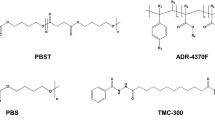Abstract
Thermotropic liquid crystal polymer (TLCP)-reinforced poly(butylene terephthalate) (PBT) composites were prepared by melt processing. The improvement in the mechanical properties and the processability of the PBT/TLCP composites was attributed to the reinforcing effect by TLCP phase and its well distribution in the PBT matrix. X-ray diffraction results demonstrated that a slow cooling process leads to the thicker lamellar structures and the formation of more regular crystallites in the composites. The incorporation of TLCP improves not only the tensile strength and flexural modulus but also the heat distortion temperature (HDT) of the PBT/TLCP composites. The HDT values of the composites were dependent on TLCP content. The improvement in the HDT values of the PBT/TLCP composites may be explained in terms with the increased flexural modulus, the development of more regular crystalline structures, and the enhancement of the ability of the composites to sustain the storage modulus by TLCP phase. In addition, the simple additivity rule makes it possible to predict the HDT values of the PBT/TLCP composites.
Similar content being viewed by others
References
H. J. Radusch, “Handbook of Thermoplastic Polyesters”, S. Fakirov ed.), Vol. 1, Wiley-VCH Verlag GmbH, Weinheim, 1993.
R. Westdyk and D. McNally, “Handbook of Plastic Materials and Technology”, (I. I. Rubin ed.), John Wiley & Sons Inc., New York, 1990.
G. Kiss,Polym. Eng. Sci.,27, 410 (1987).
D. Dutta, H. Fruitwala, A. Kohli, and R. A. Weiss,Polym. Eng. Sci.,30, 1005 (1990).
R. E. S. Bretas and D. G. Baird,Polymer,33, 5233 (1992).
S. H. Kim, “Modern Polyesters”, (J. Scheirs and T. E. Long eds.), Chap. 20, John Wiley Interscience, New York, 2004.
S. H. Kim, S. W. Park, and E. S. Gil,J. Appl. Polym. Sci.,67, 1383 (1997).
S. H. Kim, S. W. Kang, J. K. Park, and Y. H. Park,J. Appl. Polym. Sci.,70, 1065 (1998).
S. H. Kim and S. W. Kang,Fibers and Polymers,1, 83 (2000).
D. S. Park and S. H. Kim,J. Appl. Polym. Sci.,87, 1842 (2003).
S. G. Lee and S. H. Kim,Polym. Int.,52, 698 (2003).
J. Y. Kim, E. S. Seo, S. H. Kim, and T. Kikutani,Macromol. Res.,11, 62 (2003).
J. Y. Kim, O. S. Kim, S. H. Kim, and H. Y. Jeon,Polym. Eng. Sci.,44, 395 (2004).
J. Y. Kim, S. H. Kim, and T. Kikutani,J. Polym. Sci. Part B: Polym. Phys.,42, 395 (2004).
J. Y. Kim, S. W. Kang, S. H. Kim, B. C. Kim, K. B. Shim, and J. G. Lee,Macromol. Res.,13, 19 (2005).
S. T. Lim, H. S. Kim, and S. H. Kim,J. Korean Fiber Soc.,34(8), 543 (1997).
J. Y. Kim and S. H. Kim,J. Polym. Sci. Part B: Polym. Phys.,43, 3600 (2005).
J. Y. Kim and S. H. Kim,J. Appl. Polym. Sci.,99, 2211 (2006).
J. Y. Kim and S. H. Kim,Polym. Int.,55, 449 (2006).
M. P. Sepe, ASTM Spec. Tech. Publ., STP 1369 (Limitations of test methods for plastics), pp.44–53, 2000.
L. E. Alexander, “X-ray Diffraction Methods in Polymer Science”, Wiley, New York, 1969.
L. E. Nielsen, “Mechanical Properties of Polymers and Composites”, Vol. 2, Marcel Dekker, New York, 1974.
D. Jarus, A. Scheibelhoffer, A. Hiltner, and E. Baer,J. Appl. Polym. Sci.,60, 209 (1996).
M. J. Troughton, G. R. Davies, and I. M. Ward,Polymer,30, 58 (1989).
M. Yokouchi, Y. Sakakibara, Y. Chatani, H. Tadokoro, T. Tanaka, and K. Yoda,Macromolecules,9, 266 (1976).
A. Kaito, M. Kyotani, and K. Nakayama,Macromolecules,23, 1035 (1990).
T. Nakinpong, S. Bualek-Limcharoen, A. Bhutton, O. Aungsupravate, and T. Amornsakchai,J. Appl. Polym. Sci.,84, 561 (2002).
R. Verma, H. Marand, and B. Hsiao,Macromolecules,29, 7767 (1996).
C. G. Vonk,J. Appl. Cryst.,8, 81 (1973).
G. Xue, G. Ji, H. Yan, and M. Guo,Macromolecules,31, 7706 (1998).
A. C. Y. Wong,Composites: Part B,34, 199 (2003).
J. L. Thomasson and W. M. Groenewoud,Composites: Part A,27, 555 (1996).
Author information
Authors and Affiliations
Corresponding author
Rights and permissions
About this article
Cite this article
Kim, J.Y., Kang, S.W. & Kim, S.H. Thermotropic liquid crystal polymer reinforced poly(butylene terephthalate) composites to improve heat distortion temperature and mechanical properties. Fibers Polym 7, 358–366 (2006). https://doi.org/10.1007/BF02875767
Received:
Revised:
Accepted:
Issue Date:
DOI: https://doi.org/10.1007/BF02875767




